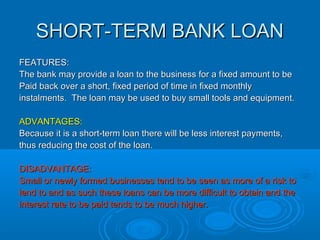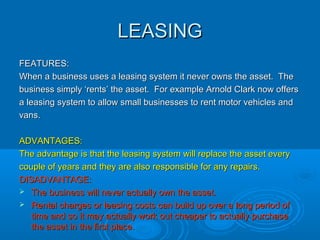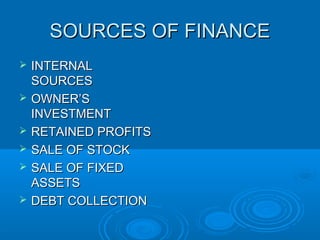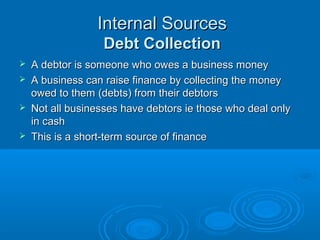Sources Of Finance
- 1. 11
- 2. Why do Business Need Finance?Why do Business Need Finance? Businesses may need to look for finance fromBusinesses may need to look for finance from banks or other investors for helping to start abanks or other investors for helping to start a business, keep a business going or for expandingbusiness, keep a business going or for expanding a business.a business. Businesses can access many different sources ofBusinesses can access many different sources of finance. The source of finance, used depends onfinance. The source of finance, used depends on what the finance is for and how long it is requiredwhat the finance is for and how long it is required for.for.
- 3. SOURCES OF FINANCESOURCES OF FINANCE DEBT FACTORINGDEBT FACTORING LONG-TERM BANK LOAN LONG-TERM BANK LOAN SHORT-TERM BANK LOAN SHORT-TERM BANK LOAN BANK OVERDRAFT BANK OVERDRAFT HIRE PURCHASEHIRE PURCHASE LEASINGLEASING MORTGAGEMORTGAGE ADDITIONAL CAPITAL ADDITIONAL CAPITAL GRANTGRANT RETAINED PROFITS RETAINED PROFITS TRADE CREDITTRADE CREDIT SOURCES OF FINANCE
- 4. DEBT FACTORINGDEBT FACTORING FEATURES:FEATURES: When customers who buy on credit fail to pay on time or attempt not toWhen customers who buy on credit fail to pay on time or attempt not to pay at all the business can use a factoring service. The factor will buypay at all the business can use a factoring service. The factor will buy the debts of the business and they will then attempt to recover paymentthe debts of the business and they will then attempt to recover payment from the customers.from the customers. ADVANTAGE:ADVANTAGE: This saves the business time pursuing customers and ensures theThis saves the business time pursuing customers and ensures the business receives most of the money it is owed, thus helping with cashbusiness receives most of the money it is owed, thus helping with cash flow.flow. DISADVANTAGE:DISADVANTAGE: The factor charges the business a fee for their service and so thisThe factor charges the business a fee for their service and so this reduces the amount of cash they will actually receive.reduces the amount of cash they will actually receive.
- 5. LONG-TERM BANK LOANLONG-TERM BANK LOAN FEATURES:FEATURES: The bank may give a loan for a fixed amount, to be paid back over a fixedThe bank may give a loan for a fixed amount, to be paid back over a fixed period of time in fixed instalments. A long-term loan might be taken out to buyperiod of time in fixed instalments. A long-term loan might be taken out to buy a very expensive piece of machinery and be re-paid over a 5 year period.a very expensive piece of machinery and be re-paid over a 5 year period. ADVANTAGE:ADVANTAGE: The business is able to purchase machinery now and use it in the businessThe business is able to purchase machinery now and use it in the business to start generating profit.to start generating profit. Repayments are spread out over a long period of time, thus helping cashRepayments are spread out over a long period of time, thus helping cash flow.flow. DISADVANTAGES:DISADVANTAGES: The business has now incurred debt and must ensure that all monthlyThe business has now incurred debt and must ensure that all monthly payments are made on time.payments are made on time. Interest is usually charged on top of the initial loan amount and so this canInterest is usually charged on top of the initial loan amount and so this can be a very expensive way of purchasing equipment and machinerybe a very expensive way of purchasing equipment and machinery
- 6. SHORT-TERM BANK LOANSHORT-TERM BANK LOAN FEATURES:FEATURES: The bank may provide a loan to the business for a fixed amount to beThe bank may provide a loan to the business for a fixed amount to be Paid back over a short, fixed period of time in fixed monthlyPaid back over a short, fixed period of time in fixed monthly instalments. The loan may be used to buy small tools and equipment.instalments. The loan may be used to buy small tools and equipment. ADVANTAGES:ADVANTAGES: Because it is a short-term loan there will be less interest payments,Because it is a short-term loan there will be less interest payments, thus reducing the cost of the loan.thus reducing the cost of the loan. DISADVANTAGE:DISADVANTAGE: Small or newly formed businesses tend to be seen as more of a risk toSmall or newly formed businesses tend to be seen as more of a risk to lend to and as such these loans can be more difficult to obtain and thelend to and as such these loans can be more difficult to obtain and the interest rate to be paid tends to be much higher.interest rate to be paid tends to be much higher.
- 7. BANK OVERDRAFTBANK OVERDRAFT FEATURES:FEATURES: A business can overdraw from their bank account, ie, spend moreA business can overdraw from their bank account, ie, spend more than they have in their bank account up to an agreed limit.than they have in their bank account up to an agreed limit. They could, for example, pay staff wages from their bank account evenThey could, for example, pay staff wages from their bank account even though they have no money in their account.though they have no money in their account. ADVANTAGE:ADVANTAGE: This allows the business to pay bills and wages on time and keep theThis allows the business to pay bills and wages on time and keep the business running smoothly.business running smoothly. DISADVANTAGES:DISADVANTAGES: This can work out expensive if used for a long time as interest isThis can work out expensive if used for a long time as interest is charged daily.charged daily. The facility may be withdrawn immediately if the limit is exceeded.The facility may be withdrawn immediately if the limit is exceeded.
- 8. HIRE PURCHASEHIRE PURCHASE FEATURES:FEATURES: Higher purchase allows a business to buy an asset such as a delivery van andHigher purchase allows a business to buy an asset such as a delivery van and pay it back over 36 months. A deposit is required followed by monthlypay it back over 36 months. A deposit is required followed by monthly payments over a few years.payments over a few years. ADVANTAGES:ADVANTAGES: This allows the business to purchase items like vehicles with only a small initialThis allows the business to purchase items like vehicles with only a small initial outlay of money.outlay of money. DISADVANTAGES:DISADVANTAGES: The business does not legally own the asset bought eg delivery vanThe business does not legally own the asset bought eg delivery van until the last payment has been made.until the last payment has been made. Interest is usually charged and so it can be an overall more expensive way ofInterest is usually charged and so it can be an overall more expensive way of purchasing large items.purchasing large items.
- 9. LEASINGLEASING FEATURES:FEATURES: When a business uses a leasing system it never owns the asset. TheWhen a business uses a leasing system it never owns the asset. The business simply ‘rents’ the asset. For example Arnold Clark now offersbusiness simply ‘rents’ the asset. For example Arnold Clark now offers a leasing system to allow small businesses to rent motor vehicles anda leasing system to allow small businesses to rent motor vehicles and vans.vans. ADVANTAGES:ADVANTAGES: The advantage is that the leasing system will replace the asset everyThe advantage is that the leasing system will replace the asset every couple of years and they are also responsible for any repairs.couple of years and they are also responsible for any repairs. DISADVANTAGE:DISADVANTAGE: The business will never actually own the asset.The business will never actually own the asset. Rental charges or leasing costs can build up over a long period ofRental charges or leasing costs can build up over a long period of time and so it may actually work out cheaper to actually purchasetime and so it may actually work out cheaper to actually purchase the asset in the first place.the asset in the first place.
- 10. MORTGAGEMORTGAGE FEATURES:FEATURES: A common method of financing land and premises is to take out aA common method of financing land and premises is to take out a mortgage which is a type of long-term loan secured against the titlemortgage which is a type of long-term loan secured against the title deeds of a property or piece of land. Mortgages are paid back over adeeds of a property or piece of land. Mortgages are paid back over a long period of time (up to 25 years).long period of time (up to 25 years). ADVANTAGES:ADVANTAGES: The business is given a long period of time (25 years) to pay theThe business is given a long period of time (25 years) to pay the mortgage back.mortgage back. DISADVANTAGES:DISADVANTAGES: Interest has to be paid on top of the initial amount borrowed.Interest has to be paid on top of the initial amount borrowed. If the business does not pay the mortgage back or falls drasticallyIf the business does not pay the mortgage back or falls drastically behind with repayments, the lender (bank or building society) canbehind with repayments, the lender (bank or building society) can claim ownership of the property or land.claim ownership of the property or land.
- 11. ADDITIONAL CAPITALADDITIONAL CAPITAL FEATURES:FEATURES: This is where the amount of money invested in the business by theThis is where the amount of money invested in the business by the owner is increased by the owners (they take more of their ownowner is increased by the owners (they take more of their own personal savings and ‘lend’ it to the business. Or they may decide topersonal savings and ‘lend’ it to the business. Or they may decide to invite a partner to join the business.invite a partner to join the business. ADVANTAGE:ADVANTAGE: The business does not need to pay back the money which has beenThe business does not need to pay back the money which has been invested and there is no interest to pay or any other costs involved.invested and there is no interest to pay or any other costs involved. DISADVANTAGES:DISADVANTAGES: The owner/s are now risking more of their own personal money asThe owner/s are now risking more of their own personal money as more of their private savings are ‘tied up’ in the business.more of their private savings are ‘tied up’ in the business. If a partner is now involved in running the business, profits now haveIf a partner is now involved in running the business, profits now have to be shared and so each owner gets a smaller share of the profits.to be shared and so each owner gets a smaller share of the profits.
- 12. GRANTGRANT FEATURES:FEATURES: A source of finance from central government or local government,A source of finance from central government or local government, Business Gateway or the Princes Trust. Money is given to theBusiness Gateway or the Princes Trust. Money is given to the business in return for starting a new business, creating jobs orbusiness in return for starting a new business, creating jobs or setting up business in an area of urban decay.setting up business in an area of urban decay. ADVANTAGE:ADVANTAGE: In most cases the money does not have to be repaid.In most cases the money does not have to be repaid. DISADVANTAGES:DISADVANTAGES: It is usually a one-off payment and certain conditions or criteria mustIt is usually a one-off payment and certain conditions or criteria must be met before it can be obtained.be met before it can be obtained. Usually the business is told what the money must be used for.Usually the business is told what the money must be used for.
- 13. RETAINED PROFITSRETAINED PROFITS FEATURES:FEATURES: A business can keep some of its profits rather than distributing them toA business can keep some of its profits rather than distributing them to the owners. In this way they can re-invest the profits back into thethe owners. In this way they can re-invest the profits back into the business to help it to expand eg by buying new equipment.business to help it to expand eg by buying new equipment. ADVANTAGE:ADVANTAGE: The advantage is that there is no interest to be paid and the businessThe advantage is that there is no interest to be paid and the business isis not incurring any debts. The business will own the assets straightnot incurring any debts. The business will own the assets straight away.away. DISADVANTAGES:DISADVANTAGES: When a business spends all of its profits it can run into cash flowWhen a business spends all of its profits it can run into cash flow problems. They may not be able to pay for any unexpected costs orproblems. They may not be able to pay for any unexpected costs or expenses as all profit has been spent.expenses as all profit has been spent.
- 14. TRADE CREDITTRADE CREDIT FEATURES:FEATURES: Businesses can buy goods from suppliers and then arrange to pay forBusinesses can buy goods from suppliers and then arrange to pay for them at a later date eg in 30 days or 60 days.them at a later date eg in 30 days or 60 days. ADVANTAGE:ADVANTAGE: This gives the business time to sell the products at a higher price, earnThis gives the business time to sell the products at a higher price, earn a profit and then pay their suppliers – hopefully before the bill ora profit and then pay their suppliers – hopefully before the bill or invoice arrives.invoice arrives. DISADVANTAGE:DISADVANTAGE: Sometimes suppliers offer a cash discount (reduction in price) forSometimes suppliers offer a cash discount (reduction in price) for prompt payment. The firm will lose the cash discount if they takeprompt payment. The firm will lose the cash discount if they take too long to pay.too long to pay. Suppliers may be reluctant to sell more goods on credit if theSuppliers may be reluctant to sell more goods on credit if the business struggles to pay on time.business struggles to pay on time.
- 15. SHORT, MEDIUM OR LONG-SHORT, MEDIUM OR LONG- TERM FINANCE?TERM FINANCE? Short-term finance is covered by trade credit, bankShort-term finance is covered by trade credit, bank overdraft, debt factoring or a short-term loan.overdraft, debt factoring or a short-term loan. Medium-term finance is a covered by a bank loan,Medium-term finance is a covered by a bank loan, Hire purchase, leasing or a grant.Hire purchase, leasing or a grant. Long-term finance is covered by a mortgage,Long-term finance is covered by a mortgage, capital invested by owners and retained profits.capital invested by owners and retained profits.
- 16. INTERNAL OR EXTERNALINTERNAL OR EXTERNAL FINANCE?FINANCE? Internal finance comes from owner’s capitalInternal finance comes from owner’s capital and retained profits.and retained profits. External finance comes from loans,External finance comes from loans, mortgages, grants, hire purchase, leasing,mortgages, grants, hire purchase, leasing, bank overdraft, trade credit and debtbank overdraft, trade credit and debt factoringfactoring
- 17. SOURCES OF FINANCESOURCES OF FINANCE INTERNALINTERNAL SOURCESSOURCES OWNER’SOWNER’S INVESTMENTINVESTMENT RETAINED PROFITSRETAINED PROFITS SALE OF STOCKSALE OF STOCK SALE OF FIXEDSALE OF FIXED ASSETSASSETS DEBT COLLECTIONDEBT COLLECTION
- 18. Internal SourcesInternal Sources Owner’s investmentOwner’s investment This is money which comes from the owner/s ownThis is money which comes from the owner/s own savingssavings It may be in the form of start up capital - used when theIt may be in the form of start up capital - used when the business is setting upbusiness is setting up It may be in the form of additional capital – perhaps usedIt may be in the form of additional capital – perhaps used for expansionfor expansion This is a long-term source of financeThis is a long-term source of finance
- 19. Internal SourcesInternal Sources Owner’s investmentOwner’s investment AdvantagesAdvantages Doesn’t have to be repaidDoesn’t have to be repaid No interest is payableNo interest is payable DisadvantagesDisadvantages There is a limit to the amount an owner can investThere is a limit to the amount an owner can invest
- 20. Internal SourcesInternal Sources Retained ProfitsRetained Profits This source of finance is only available for a businessThis source of finance is only available for a business which has been trading for more than one yearwhich has been trading for more than one year It is when the profits made are ploughed back into theIt is when the profits made are ploughed back into the businessbusiness This is a medium or long-term source of financeThis is a medium or long-term source of finance
- 21. Internal SourcesInternal Sources Retained ProfitsRetained Profits AdvantagesAdvantages Doesn’t have to be repaidDoesn’t have to be repaid No interest is payableNo interest is payable DisadvantagesDisadvantages Not available to a new businessNot available to a new business Business may not make enough profit to plough backBusiness may not make enough profit to plough back
- 22. Internal SourcesInternal Sources Sale of StockSale of Stock This money comes in from selling off unsold stockThis money comes in from selling off unsold stock This is what happens in the January salesThis is what happens in the January sales It is when the profits made are ploughed back into theIt is when the profits made are ploughed back into the businessbusiness This is a short-term source of financeThis is a short-term source of finance
- 23. Internal SourcesInternal Sources Sale of StockSale of Stock AdvantagesAdvantages Quick way of raising financeQuick way of raising finance By selling off stock it reduces the costs associated withBy selling off stock it reduces the costs associated with holding themholding them DisadvantagesDisadvantages Business will have to take a reduced price for the stockBusiness will have to take a reduced price for the stock
- 24. Internal SourcesInternal Sources Sale of Fixed AssetsSale of Fixed Assets This money comes in from selling off fixed assets, suchThis money comes in from selling off fixed assets, such as:as: a piece of machinery that is no longer neededa piece of machinery that is no longer needed Businesses do not always have surplus fixed assetsBusinesses do not always have surplus fixed assets which they can sell offwhich they can sell off There is also a limit to the number of fixed assets a firmThere is also a limit to the number of fixed assets a firm can sell offcan sell off This is a medium-term source of financeThis is a medium-term source of finance
- 25. Internal SourcesInternal Sources Sale of Fixed AssetsSale of Fixed Assets AdvantagesAdvantages Good way to raise finance from an asset that is no longerGood way to raise finance from an asset that is no longer neededneeded DisadvantagesDisadvantages Some businesses are unlikely to have surplus assets toSome businesses are unlikely to have surplus assets to sellsell Can be a slow method of raising financeCan be a slow method of raising finance
- 26. Internal SourcesInternal Sources Debt CollectionDebt Collection A debtor is someone who owes a business moneyA debtor is someone who owes a business money A business can raise finance by collecting the moneyA business can raise finance by collecting the money owed to them (debts) from their debtorsowed to them (debts) from their debtors Not all businesses have debtors ie those who deal onlyNot all businesses have debtors ie those who deal only in cashin cash This is a short-term source of financeThis is a short-term source of finance
- 27. Internal SourcesInternal Sources Debt CollectionDebt Collection AdvantagesAdvantages No additional cost in getting this finance, it is part of theNo additional cost in getting this finance, it is part of the businesses’ normal operationsbusinesses’ normal operations DisadvantagesDisadvantages There is a risk that debts owed can go bad and not beThere is a risk that debts owed can go bad and not be repaidrepaid


























